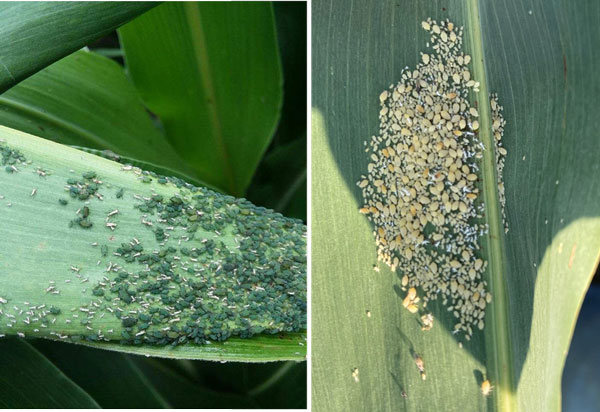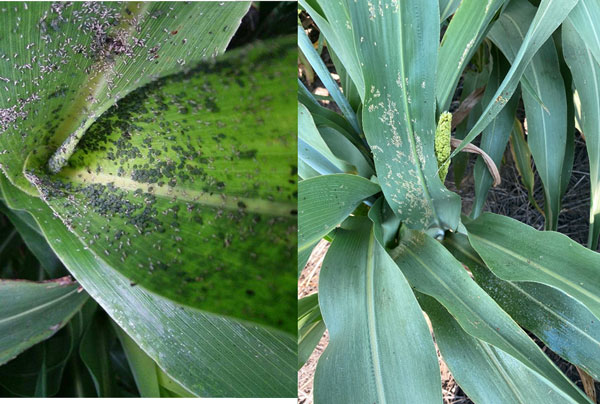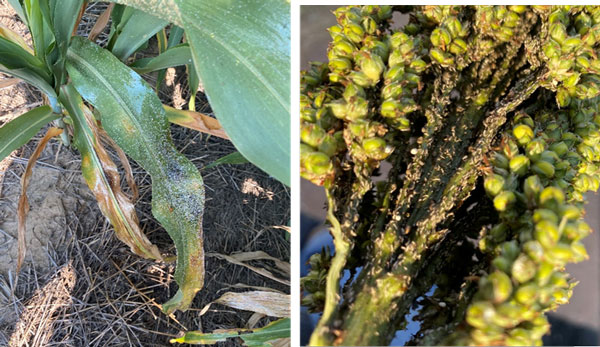The sugarcane aphid has now been reported in several counties in Kansas as seen below in the map highlighted in green (Figure 1). Grain sorghum producers in Kansas should continue scouting their fields on a routine basis.

Figure 1. Current status of the SCA. The map indicates only the counties in which the SCA has been found and does not indicate how many or how few aphids were found in that county. Source: https://www.myfields.info/pests/sugarcane-aphid
There have been several reports of declining corn leaf aphid populations and an increase in sugarcane aphid (SCA) populations this week in sorghum fields (Figure 2). Corn leaf aphids can be very profuse and produce lots of honey dew, however they can be beneficial to have around as they bring in LOTS of predators (Figure 3)!! Corn leaf aphids rarely need to be sprayed in sorghum and keep the predators around to take care of those pesky SCA. Parasitoids are still having trouble laying eggs inside some populations of SCA, but other predators are picking SCA off.

Figure 2. LEFT: corn leaf aphids on sorghum, RIGHT: sugarcane aphids in sorghum. Photos by K-State Research and Extension.

Figure 3. LEFT: corn leaf aphids will often infest the sorghum whorl and the emerging sorghum head, RIGHT: sugarcane aphids prefer to infest the leaves of the sorghum plant but eventually may move into the head later in the season. Photos by K-State Research and Extension.
Scouting time for SCA
Early detection is key to the management of this pest, but treatments should be based on established thresholds. One heavily infested plant does not equal a yield loss. Applying insecticides too soon can result in repeated applications.
Plants are vulnerable to infestation by SCA at any growth stage, but Kansas sorghum is most at risk from boot stage onward. The ability of sugarcane aphid to overwinter on Johnsongrass and re-sprouting sorghum stubble represents challenges to the management of this pest in more southerly regions.
Issues arising from SCA in Kansas are likely to become increasingly uncommon with each passing year. However, there is a good amount of late-planted sorghum this year that is going to be more at risk going into late summer. Producers would be wise to scout these late-planted fields.
Sampling method
- Once a week, walk 25 feet into the field and examine plants along 50 feet of row:
- If honeydew is present, look for SCA on the underside of a leaf above the honeydew.
- Inspect the underside of leaves from the upper and lower canopy from 15–20 plants per location.
- Sample each side of the field as well as sites near Johnsongrass and tall mutant plants.
- Check at least 4 locations per field for a total 4 locations per field for a total of 60-80 plants.
If no SCA are present, or only a few wingless/winged aphids are on upper leaves, repeat this sampling method once a week thereafter.
If SCA are found on lower or mid-canopy leaves, begin twice-a-week scouting. Use the same sampling method, but be sure to include % plants with honeydew. Estimate the % of infested plants with large amounts of SCA honeydew (shiny, sticky substance on leaf surface) to help time foliar insecticides for SCA control on sorghum (Table 1).
Table 1. SCA Thresholds
|
Growth Stage |
Threshold |
|
Pre-Boot |
20% plants infested with localized area of heavy honeydew and established aphid colonies |
|
Boot |
20% plants infested with localized area of heavy honeydew and established aphid colonies |
|
Soft dough |
30% plants infested with localized area of heavy honeydew and established aphid colonies |
|
Dough |
30% plants infested with localized area of heavy honeydew and established aphid colonies |
|
Black Layer |
Heavy honeydew and established aphid colonies in head *only treat to prevent harvest problems **observe pre-harvest intervals |

Figure 4. LEFT: Evidence of sugarcane aphids including their shed skins and their honey dew, RIGHT: evidence of corn leaf aphids including old honey dew and shed skins. Photos by K-State Research and Extension.
For ongoing current information on SCA in Kansas, check out the myFields web site often in the coming weeks and months: https://www.myfields.info/pests/sugarcane-aphid
Please email R. Max Dunlap (xammax@ksu.edu) with counties to add to the map!!
Sarah Zukoff, Entomologist, Southwest Research-Extension Center
snzukoff@ksu.edu
J.P. Michaud, Entomologist, Agricultural Research Center-Hays
jpmi@ksu.edu
Brian McCornack, Entomologist
mccornac@ksu.edu
R. Max Dunlap, myfields.info
xammax@ksu.edu
Tags: sorghum sugarcane aphid SCA